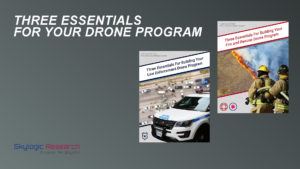
As public safety programs around the country adopt drone technology to keep their teams and their communities safer, many struggle with how to get started. In these free resources developed by top drone analyst Colin Snow, departments of every size can take advantage of the lessons learned by early adopters.
The following is a Skylogic Research article.
Increasing use of drones surfaces three best practices for state and local police, sheriffs, fire departments, and teams in EMS, search and rescue, tactical response, and disaster response.
Skylogic Research just released two new drone industry guides titled Three Essentials For Building Your Law Enforcement Drone Program and Three Essentials For Building Your Fire and Rescue Drone Program.
These are the first in a series of papers intended to share the latest lessons learned in specific industries and how to sustain and grow a drone program.
These guides offer essential best practices for law enforcement and fire and rescue teams. They answer questions like:
- What have current users learned about what works and what doesn’t?
- What are the most important topics to know to keep your drone program ongoing?
- And where should you go to learn what’s next?
Here is an excerpt from the law enforcement guide:
Essential 1 – Take advantage of the latest technology
New technology is progressing rapidly in drones and aerial imaging processing—more rapidly and at lower costs than manned-based aviation solutions. It is important to keep up with the changes that could benefit your program. Nearly every week, a new product is announced. Two of the most exciting recent developments are smaller combination sensors and augmented reality.
The new sensors, like the one found on the DJI Mavic Enterprise Dual, combine visible and thermal imagery in one sensor. Multiple display modes allow you to see either the infrared or the visible image or a combination. Isotherm readouts help you get accurate heat measurements on a variety of objects and scenarios. This gives tactical teams more flexibility–they may no longer need to fly two drones each with its own sensor or deal with the complexity of landing and swapping out two separate sensors on the same drone.
ACTION: Keep up to date by attending at least one commercial drone show a year. When evaluating drone solutions or software applications, ask how new capabilities can meet your mission requirements. If you don’t have a list of mission requirements, start with a narrow scope of operation. For instance, we recommend you treat drones as a response tool—not a patrol tool—and pick from a list of four operations that your constituents would find most palatable: search and rescue, accident scene documentation, pursuit of an armed suspect, and disaster mitigation.
The guides describe what many police, fire, and emergency responders have learned from their programs and recommend the actions you should take for successful implementation and ongoing use.
You can download the free guides here:
Three Essentials For Building Your Law Enforcement Drone Program: http://bit.ly/2UbrXcY
Three Essentials For Building Your Fire and Rescue Drone Program: http://bit.ly/2vHIiaM
Miriam McNabb is the Editor-in-Chief of DRONELIFE and CEO of JobForDrones, a professional drone services marketplace, and a fascinated observer of the emerging drone industry and the regulatory environment for drones. Miriam has penned over 3,000 articles focused on the commercial drone space and is an international speaker and recognized figure in the industry. Miriam has a degree from the University of Chicago and over 20 years of experience in high tech sales and marketing for new technologies.
For drone industry consulting or writing, Email Miriam.
TWITTER:@spaldingbarker
Subscribe to DroneLife here.